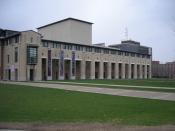The microeconomic picture of the U.S. has changed immensely since
1973, and the trends are proving to be consistently downward for
the nation's high school graduates and high school drop-outs. "Of all
the reasons given for the wage squeeze - international competition,
technology, deregulation, the decline of unions and defense cuts -
technology is probably the most critical. It has favored the
educated and the skilled," says M. B. Zuckerman, editor-in-chief of
U.S. News & World Report (7/31/95). Since 1973, wages adjusted
for inflation have declined by about a quarter for high school
dropouts, by a sixth for high school graduates, and by about 7% for
those with some college education. Only the wages of college
graduates are up.
Of the fastest growing technical jobs, software engineering
tops the list. Carnegie Mellon University reports, "recruitment of it's
software engineering students is up this year by over 20%." All
engineering jobs are paying well, proving that highly skilled labor is
what employers want! "There is clear evidence that the supply of
workers in the [unskilled labor] categories already exceeds the
demand for their services," says L.
Mishel, Research Director of
Welfare Reform Network. In view of these facts, I wonder if these
trends are good or bad for society. "The danger of the information
age is that while in the short run it may be cheaper to replace
workers with technology, in the long run it is potentially self-
destructive because there will not be enough purchasing power to
grow the economy," M. B. Zuckerman. My feeling is that the trend
from unskilled labor to highly technical, skilled labor is a good one!
But, political action must be taken to ensure that this societal
evolution is beneficial to all of us. "Back in 1970, a high school
diploma could still be...


